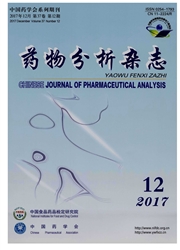

 中文摘要:
中文摘要:
目的:应用DNA条形码技术,从分子水平快速、准确地鉴定我国12个省区铁皮石斛栽培基地铁皮石斛(Dendrobium officinale Kimura et Migo)及其同属常见植物的基原,采用微波消解ICP-MS技术测定各地铁皮石斛中铅(Pb)、镉(Cd)、砷(As)、汞(Hg)、铜(Cu)5种重金属及有害元素的含量,评价栽培铁皮石斛的用药安全。方法:提取各样本总DNA,对r DNA的第二内转录间隔区(ITS2区)进行扩增,计算种内、种间Kimura 2-parameter(K2P)遗传距离,通过与中药材DNA条形码鉴定系统比对和构建N-J(Neighbor-Joining)系统树进行基原鉴定。建立微波消解方法进行样品前处理,ICP-MS法对铁皮石斛中5种重金属及有害元素进行测定,比对国内外现行标准,对铁皮石斛的安全性进行评价。结果:铁皮石斛的ITS2序列长度在246-340bp范围,种内变异较小,种内最大K2P遗传距离为0.009,铁皮石斛及其混伪品的种间平均K2P遗传距离为0.206,种间最小K2P遗传距离明显大于种内的最大K2P遗传距离。经与中药材DNA条形码鉴定系统比对及构建N-J树进行基原鉴定。结果表明ITS2序列可区分铁皮石斛及其近缘种。5种重金属及有害元素的测定结果表明各地的含量差异较显著,但在安全的范围内。结论:ITS2片段DNA条形码可有效鉴定中药铁皮石斛及其常见同属植物的基原,建立的ICP-MS法测定铁皮石斛中5种重金属与有害元素的方法准确、可行,各元素的含量在现行相关标准的安全范围内。
 英文摘要:
英文摘要:
Objective:To identify Dendrobium officinale and its common affinitive species on a molecule level by using ITS2 barcoding technique,and to evaluate the medication safety of Dendrobium officinale from 12 provinces in China through detection of five heavy metals and hazardous elements of Pb,Cd,As,Hg,and Cu by microwave digestion and ICP-MS technique.Methods:Total genomic DNA was extracted from Dendrobium officinale.The internal transcribed spacer 2(ITS2) regions were amplified using polymerase chain reaction(PCR),and PCR products were sequenced bi-directionally.The Kimura 2-parameter(K2P) distances and nucleotide composition of GC content were computed.Alignment with the known sequence from Gen Bank and species identification analyses were conducted through the species identification system of neighbor-joining(N-J) trees.The contents of 5 heavy metals and hazardous elements in Dendrobii Officinalis Caulis were determined successfully.The safety was evaluated by comparison of the domestic and foreign correlated standards.Results:The ITS2 sequence lengths of Dendrobium officinale were within 246-340 bp,and the intra-species variation was small.The maximum intra-specific genetic distances of Dendrobium officinale was 0.009.The average inter-specific genetic distances between Dendrobium officinale and analogues species were 0.206.The results showed that the minimum inter-specific divergence was larger than the maximum intra-specific divergence.The results of the species identification system for traditional Chinese medicine by DNA barcodes and N-J trees indicated that Dendrobium officinale and the affinitive species can be clearly identified.The contents of five heavy metals and hazardous elements were obviously different in Dendrobii Officinalis Caulis samples from different producing places,but all in accordance with the limits of domestic and foreign correlative standards.Conclusion:DNA barcodes can accurately identify the origin of Dendrobium officinale and its common affinitive species.The
 同期刊论文项目
同期刊论文项目
 同项目期刊论文
同项目期刊论文
 期刊信息
期刊信息
